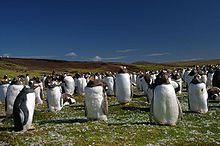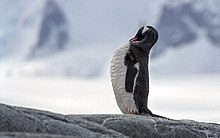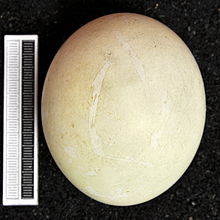Gentoo penguin
| Gentoo penguin | ||||||||||||
|---|---|---|---|---|---|---|---|---|---|---|---|---|

Gentoo penguin ( Pygoscelis papua ) |
||||||||||||
| Systematics | ||||||||||||
|
||||||||||||
| Scientific name | ||||||||||||
| Pygoscelis papua | ||||||||||||
| ( Forster , 1781) |
The Gentoo Penguin ( Pygoscelis papua ), more rarely Rotschnabelpinguin called, is a penguin - Art in the genus of long-tailed penguins ( Pygoscelis ) and most closely with the Adelie Penguin ( P. adeliae ) and the chinstrap ( P. antarctica ) related. The first scientific description under the name Aptenodytes papua was made in 1781 by Johann Reinhold Forster based on a specimen that was killed on the Falkland Islands and then brought to London.
Gentoo penguins are the fastest swimmers among the penguins, they reach up to 27 km / h (according to other sources up to 36 km / h) but only swim an average of 6 km / h. The gentoo penguin is also considered to be the shyest known species of penguin. It gets its name from the donkey-like screams that warn of egg thieves and that can also be heard during the mating season. Two subspecies are recognized, which differ only in their height. The Gentoo Penguin is classified as near threatened by the IUCN . It has an average life expectancy of 15 years.
Appearance
Gentoo penguins reach a body length between 75 and 90 centimeters. They are medium-sized penguins, only the emperor and king penguins are larger. The weight of gentoo penguins varies depending on the season and is between 4.7 and 7.4 kilograms. They reach their highest weight shortly before moulting. There is no pronounced sexual dimorphism , but the females tend to be somewhat smaller. The plumage shows no seasonal differences, juvenile birds can be distinguished from adult birds by their plumage up to an age of one year. The gentleman's most striking feature is the often triangular white spot above the eye.
The throat and head are black except for the white spot above the eye. The spot usually extends to the top of the head and merges into the white eye ring at the lower end. Individual white feathers can also be found on the head and neck. The upper body is otherwise black-blue and looks brownish shortly before moulting when the plumage is very worn. The underside of the body is white and sharply set off from the black throat. The wings, which have been transformed into fins, are white on the underside with a black spot at the end. The beak is orange-red on the sides. The surface of the upper beak and the tip of the beak are black. The iris is brown. The feet are pale whitish-pink to red.
Fledglings resemble adult birds, but are smaller and have a dull colored bill. Individual individuals are spotted gray on the throat and chin. Birds in which the white spot on the head does not extend to the white eye ring are all juveniles. However, there are individual individuals in whom this characteristic is already present in the juvenile plumage.
There is no possibility of confusion with other penguin species due to the conspicuous white spot on the face and the reddish beak.
voice
Gentoo penguins are very shouting on land. Vocalizations can be heard especially during pair formation, the establishment of the nesting territory and during the rearing of the young birds. Contact calls, on the other hand, can be heard all year round and are called by the penguins especially when they land. But they can also be heard at sea.
Geographical variations in the utterances of sounds are noticeable and are not limited to the two subspecies. Breeding birds on Macquarie Island, Crozet Island and Kerguelen Island have a slower call rhythm, lower call height and longer call phases than the gentoo penguins that breed in the Falkland Islands, South Georgia and the South Orkney Islands.
The contact call is short, choppy, and dark. The calls that are uttered during the breeding season include the loud trumpet-like calls that have led to the German-language name Eselspinguin. Calling birds stretch their heads and necks upwards and then let out a very regular series of four to five syllables. The call is circumscribed onomatopoeically as ah - aha - aha - aha . The sounds also include a soft, hissing sound that can always be heard when the parent birds take turns incubating the clutch. The threatening sounds also include hissing sounds, a grunted aaar can be heard during very aggressive arguments. The chicks beep very brightly.
distribution and habitat
Gentoo penguins are circumpolar and breed on sub-Antarctic islands and the Antarctic Peninsula . Basically, they avoid the pack ice zone. Their range outside of the breeding season has not been carefully investigated. It is generally assumed that adult gentoo penguins stay in the vicinity of their breeding colonies all year round. The marine range extends from the Southern Ocean and the South Atlantic to the South Indian Ocean . However, wanderers also reach the South American coast and are observed up to 43 ° S in Argentina. Random visitors occasionally also reach the coast of Australia and New Zealand.
The main colonies are in the Falkland Islands , where about 36% of the global population breed. There are other large breeding colonies on South Georgia and the Kerguelen . Smaller colonies breed on Macquarie Island , Heard and McDonald Islands, and the Antarctic Peninsula.
The subspecies Pygoscelis papua ellsworthii , which is slightly smaller than the nominate form , breeds on the Antarctic Peninsula with around 20,000 pairs, the southern Shetland Islands with around 17,200 pairs and, to a lesser extent, in the southern Orkney Islands .
Duration
The population is estimated by the IUCN to be 520,000 sexually mature birds and is therefore classified by the IUCN as low risk because some of the most important populations are declining. This is true even though other populations have actually increased. Where the populations have increased, the cause is considered to be reduced food competition with whales, whose populations have decreased significantly in the course of the 20th century.
In the 19th century gentoo penguin populations had declined, in some cases drastically, because the eggs were collected for human consumption and adult penguins were slaughtered to obtain oil from their fat layer. This practice was still in use in the 1910s: there is evidence that the crew of a single schooner killed over 70,000 specimens annually in the Falkland Islands in order to extract oil from them. The falls in the Falkland Islands are believed to be still related to the practice of collecting eggs. Gentoo penguins are also sensitive to human disturbance. For example, stocks on the Kerguelen have declined significantly after this island was permanently settled.
food

Gentoo penguins feed primarily on small fish , octopus and krill . In the northern colonies, fish dominates the diet. Fish is also the main food in the final phase of rearing the young and during the winter months. Gentoo penguins dive up to 212 meters, but most dives are no deeper than 110 meters. The diving depth is influenced by the food available; for numerous breeding colonies it has been proven that a large proportion of the birds do not dive more than 20 meters deep. Usually they look for food for six to ten hours.
On King George Island, 50% of the adult birds breeding there leave the breeding colony between 5 and 7 a.m. and return to the colony between 9 a.m. and 1 p.m. to relieve their partner. These then look for food in the sea and return to the breeding colony around 5 p.m. In some breeding colonies, however, some of the breeding birds remain at sea during the night. Breeding birds rarely move further than forty kilometers from their breeding colony. Gentoo penguins have also been found searching for food 105 kilometers from the breeding colony.
Predators
Their natural predators in the water are killer whales , leopard seals and large specimens of other seals. On land, adult gentoo penguins have no predators. However, eggs and chicks are occasionally preyed on by skuas .
Reproduction
The breeding colonies of gentoo penguins are basically on ice-free ground. Colonies can be located directly on the coastline, but also considerably away from it inland. They prefer flat stretches of coast and often breed between tufts of grass. In South Georgia, for example, there are breeding colonies two kilometers inland. While colonies in the interior, where the penguins breed between tufts of grass, move slightly every year because the grass is trodden down, the location of colonies on rather bare coastal stretches remains unchanged for years. In South Georgia, for example, the largest colony has been visited for more than thirty years.
The species' nests are usually made up of a circular pile of stones. They can be quite large, eight inches high and ten inches in diameter are not uncommon. The breeding season generally takes place in September. The female lays two eggs weighing approximately 130 grams. The adult birds take turns in breeding, which lasts about 34 to 36 days. After hatching, the chicks stay in their nests for about 30 days. Then they get their pre-adult plumage, which they keep for about 80 to 100 days until they molt again and are capable of diving in the sea.
Others
The GNU / Linux distribution Gentoo Linux and the BSD variant Gentoo / FreeBSD derived from it, like the file manager gentoo, were named after this penguin ( Gentoo penguin ).
In the 2011 comedy film Mr. Poppers Penguins , six gentoo penguins star alongside Jim Carrey . Most of the film was shot with real penguins.
literature
- Klemens Pütz and Christine Reinke-Kunze: Animal World of the Antarctic and Subantarctic , Antarctic Research Trust, Forch 2009, ISBN 978-3-033-01791-7
- Hadoram Shirihai: A Complete Guide to Antarctic Wildlife - The Birds and Marine Mammals of the Antarctic Continent and Southern Ocean , Alula Press, Degerby 2002, ISBN 951-98947-0-5
- Tony D. Williams: The Penguins . Oxford University Press, Oxford 1995, ISBN 0-19-854667-X
- Robin and Anne Woods: Atlas of Breeding Birds of the Falkland Islands , Anthony Nelson, Shorpshire 1997, ISBN 0-904614-60-3
Web links
- Gentoo Penguin LiveCam from O'Higgins Station
- Pygoscelis Papua in the endangered Red List species the IUCN 2008. Posted by: BirdLife International, 2008. Accessed on December 22 of 2008.
- Videos, photos and sound recordings of Pygoscelis papua in the Internet Bird Collection
Individual evidence
- ↑ Pütz and Reinke-Kunze, p. 22
- ↑ a b Woods, p. 30
- ↑ a b c d Daniel Gilpin: Penguins . Parragon Books Ltd., 2007, ISBN 978-1-4075-0629-6 , pp. 94 .
- ↑ a b c BirdLife factsheet on the Gentoo Penguin. Retrieved November 7, 2010
- ↑ a b Shirihai, p. 61
- ↑ a b c d Williams, p. 161
- ↑ a b Williams, p. 160
- ↑ a b c Williams, p. 163.
- ^ Williams, p. 162
- ^ Williams, p. 164





